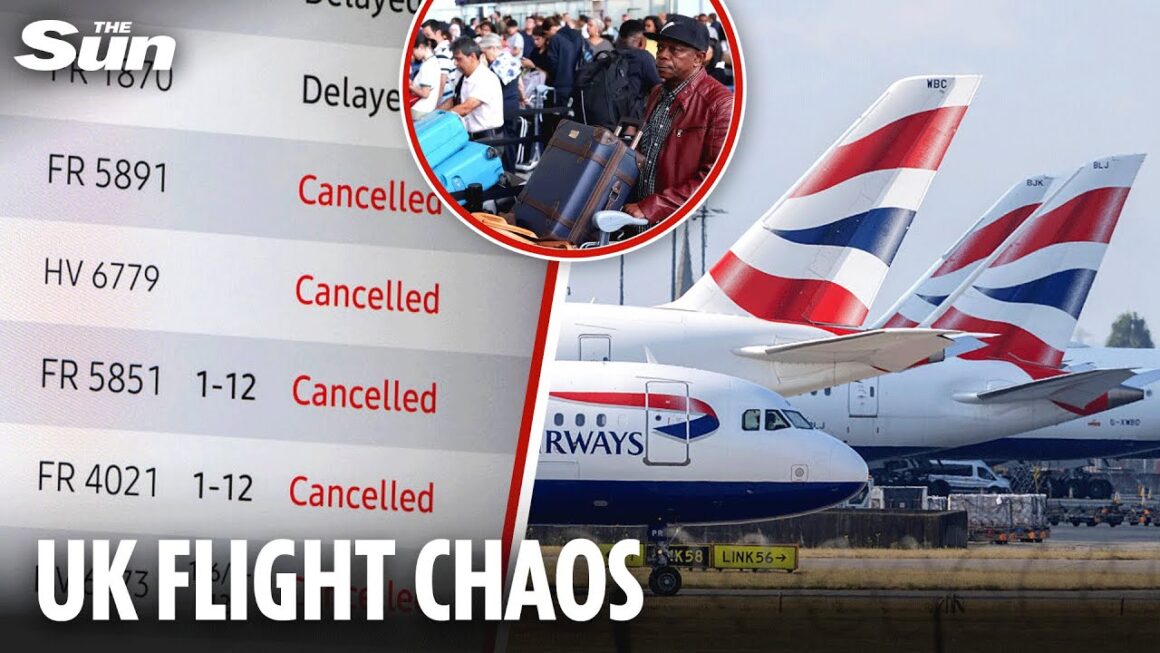
30 Minutes of Darkness That Froze a Nation’s Sky
It was just another Tuesday morning until it wasn’t. July 30, 2025, British skies—a dance of thousands of daily flights—broke rhythm. Aircraft sat immobile on tarmacs. Flying jets looped futilely overhead. In terminals, there was confusion. The boards weren’t updating: “Delayed due to radar failure.”
It was something much more mundane and sinister: a failure of the software in the very system that protects the country’s skies—a radar collapse at Swanwick control center, one of the UK’s main air traffic control centers.
Even though the breakdown lasted just below 30 minutes, it cascaded into 12 hours of spread-out disruption. More than 150 flights were grounded, over 800 others were delayed, and thousands of passengers were left stranded on runways, airports, and at terminals. The breakdown revealed a chilling reality—the vulnerability of a system entrusted with lives every moment.
When Radar Fails, the Entire Nation Holds Its Breath
Radar isn’t a flashing screen—it’s the thread of life in the sky. It follows planes’ locations in real-time, keeping aircraft from crashing into each other, airspace from being wasted, and flights landing safely even when weather doesn’t play nicely.
When the radar system at Swanwick went dark, controllers lost that visibility. They could no longer see or guide planes safely. As a result:
- Departures were immediately halted
- Incoming flights were diverted or forced into holding patterns
- Ground operations across Heathrow, Gatwick, Edinburgh, and Manchester froze
The ripple effect was enormous. Flights were delayed well into the night, and international connections were severed without warning. The event wasn’t just inconvenient—it was a breakdown of national infrastructure.
The Hard Numbers Behind a National Breakdown
This wasn’t a minor hiccup. The scale of UK aviation means even a brief system failure brings massive disruption. Here’s the reality:
- 60 million passengers used UK airports in Q1 2025
- 452,000 aircraft movements were tracked during the same period
- Heathrow alone manages 1,300 flights per day
- The average delay per flight was already 12 minutes before the incident
- On July 30, over 120,000 passengers were directly impacted
Even without a crisis, UK airspace is congested. With one radar failure, the entire system spirals.
History Repeats Itself — And This Time, No One Can Pretend to Be Surprised
What’s most troubling is this wasn’t the first time. The UK has faced similar radar or system failures before—and each time, promises of reform followed.
- December 2014: Software failure at Swanwick causes 200+ cancellations
- August 2023: A corrupted flight plan crashes NATS’s main system, affecting 2,000+ flights and causing 3 days of delays
- July 2025: Radar failure again—this time amid expectations that such collapses had been fixed
What changed since 2023? Not enough. The technology remained vulnerable. Redundancy systems weren’t stress-tested. Contingency plans remained theoretical. And once again, Britain’s airspace was brought to its knees.
Grounded Before Takeoff: What Could’ve Been Done But Wasn’t
Experts have long warned that NATS and the Department for Transport were playing with fire. The aviation backbone was aging—and overly centralized.
Several steps could have prevented or minimized this crisis:
- Geo-redundant radar systems to shift control instantly
- Cloud-based flight tracking as a secondary safety layer
- AI-powered monitoring tools to detect anomalies in real time
- Simulated stress tests for emergency preparedness
- Manual handover protocols to switch operations to Prestwick or regional centers within seconds
Yet, despite prior failures, these safeguards remained either unfinished, untested, or uninstalled.
The Finger-Pointing Begins: Who Let the Skies Go Blind?
Primary accountability rests with NATS, the organization responsible for managing UK air traffic. While the company is partly privatized, it handles a public function that millions depend on every day.
But NATS isn’t alone in this failure. The Department for Transport, the CAA (Civil Aviation Authority), and even Parliament must answer difficult questions. Why weren’t reforms prioritized after 2023? Why were airlines and passengers left without backup plans?
Blaming a “technical glitch” isn’t good enough anymore. This was not a surprise. It was a preventable repeat disaster.
From Heathrow to Hyderabad: How the Fallout Went Global
British airspace isn’t just domestic—it’s a global aviation artery. When Heathrow or Gatwick halts, the world feels it.
How the UK Radar Crash Affected Other Nations:
- Flights from India, UAE, the US, and Southeast Asia were disrupted
- Transit passengers missed connections at European and American hubs
- Cargo shipments of pharmaceuticals, electronics, and perishables faced delays
- International airlines had to reroute or cancel long-haul operations
India Felt It Sharply:
- Over 1.5 million annual passengers travel between India and the UK
- 30,000+ Indian students rely on UK-India flights every academic year
- 12 Indian cities connect directly to the UK
- Bilateral trade worth over $21 billion flows through air corridors
A radar failure in London quickly became a crisis in Delhi, Dubai, and New York.
Green Dreams, Fragile Systems: The Sustainability Contradiction
Ironically, the radar crash occurred at a time when UK aviation is aggressively pursuing sustainability. The government has committed to:
- Reducing emissions by 70% by 2050
- Digitizing airspace for more efficient routing
- Promoting electric short-haul flights and sustainable aviation fuel
But these ambitions mean little if the existing foundation can’t even handle today’s traffic, let alone tomorrow’s.
As climate volatility increases, aviation systems will be tested harder than ever:
- Heatwaves can interfere with radar hardware
- Storm surges could disrupt communication systems
- Changing wind patterns demand agile rerouting
A resilient future requires both green policy and robust engineering—not just one.
This Wasn’t Just a Glitch—It Was a Warning
The radar failure of July 30 wasn’t just an error. It was a reckoning.
It exposed a fragile system already stretched to its limit. It proved that past failures went uncorrected. It shook confidence not just in technology, but in the institutions meant to protect it.
In aviation, time is precious. So is trust. And when either is lost, the consequences echo far beyond the runway.
FOR MORE BLOGS –beyondthepunchlines.com

 Add to favorites
Add to favorites







